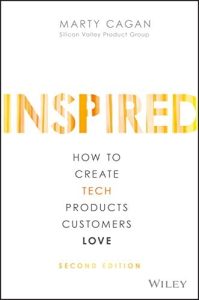“Inspired: How to Create Tech Products Customers Love” is a book by Marty Cagan, a product management expert, that provides guidance on how to create successful technology products.

Here are the main takeaway from the Book:
- Understand your customers: The book stresses the importance of understanding the needs and wants of your customers, and how to create products that meet those needs.
- Emphasize a strong product vision: A strong product vision is crucial for guiding the development of a successful product, and the book provides guidance on how to create and communicate a compelling vision.
- Build a cross-functional team: A cross-functional team that includes representatives from engineering, design, product management, and other disciplines is essential for creating successful products.
- Use a customer-centric approach: The book advocates for a customer-centric approach to product development, where the customer is at the center of all decisions.
- Use data and experimentation: The book encourages using data and experimentation to validate product ideas and make data-driven decisions.
- Focus on creating value: The book emphasizes the importance of creating value for customers and avoiding features that don’t contribute to that goal.
- Prioritize product backlog: The book highlights the importance of having a clear product backlog and prioritizing features based on their impact on the customer.
- Iterate quickly: The book encourages a rapid iteration process, where feedback is incorporated early and often.
- Create a product roadmap: The book explains the importance of having a clear product roadmap that communicates the direction of the product to the team and stakeholders. It is worth noting that we often create “bad” roadmaps that is “a list of prioritized specs and features that someone believes are the solution to the problem the product is solving”; it is worth reading Marty’s essay on this here.
- Lead with influence: The book highlights the importance of leadership skills in creating successful products, and offers strategies for leading with influence.

Sourced: ProductBoard Blog Post
Marty Cagan explains that a product roadmap is a high-level plan that communicates the direction of the product to the team and stakeholders, and highlights the most important initiatives and features that will be delivered over a period of time. He also stresses the importance of having a clear and well-communicated product roadmap that guides the product development process and keeps the team aligned and focused.
He explains that a good product roadmap should be:
- Vision-driven: aligned with the product vision and the overall business strategy
- Prioritized: based on the impact on the customer and the business
- Flexible (Agile!): able to adapt to changes and pivot when necessary
- Communicated: shared with the team and stakeholders to keep them informed and aligned.
Cagan also emphasize that a product roadmap is not a detailed plan, but a high-level view of the most important initiatives and features that will be delivered over a period of time. It’s a living document that should be regularly updated and communicated to reflect the current priorities and changes in the market or the business. He encourages product managers to use the roadmap as a tool to align the team, communicate the product direction and make data-driven decisions.
Product Managers and Product Owners
In the Book, Marty Cagan highlights the difference between the product manager and product owner roles.
He explains that the product manager role is responsible for the overall strategy and vision of the product, and they are the key decision-makers in the product development process. They are responsible for understanding the market and the customers, setting the product vision and strategy, and working with cross-functional teams to develop and deliver the product.While the product owner role is responsible for representing the customer and the business in the development process, and for prioritizing the backlog of features and initiatives. They are responsible for ensuring that the development team is working on the most important and valuable features, and that the product is aligned with the overall strategy and vision.
The author mentions that in some companies the product manager and product owner roles may be combined, but in others the roles may be separated. It is important to understand the difference between the two roles and attempt to have the right people in place to effectively streamline the product development process.
Briefly, product manager role is responsible for the overall strategy and vision of the product, while the product owner role is responsible for representing the customer and the business in the development process, and for prioritizing the backlog of features and initiatives.
“Inspired: How to Create Tech Products Customers Love” is a good guide for product managers, entrepreneurs and other technology leaders on how to create successful technology products by understanding the customers, creating a strong vision, building cross-functional teams, using data-driven approach, and leading with influence.

Leave a Reply